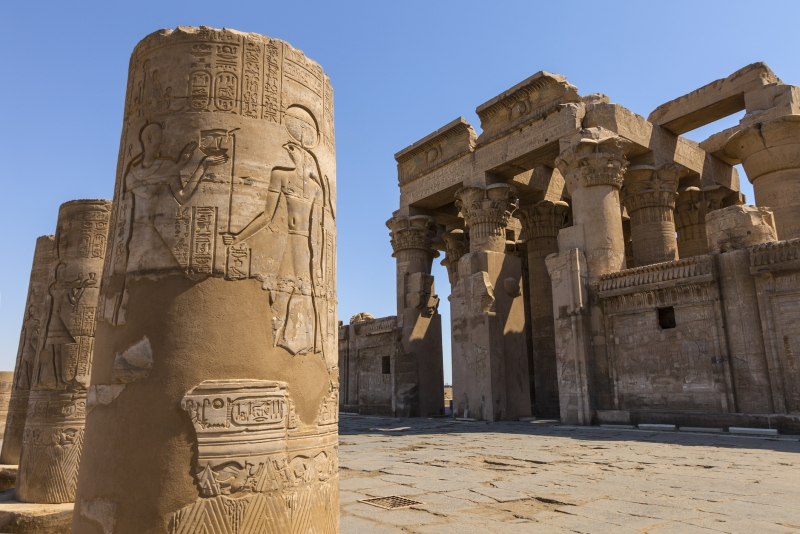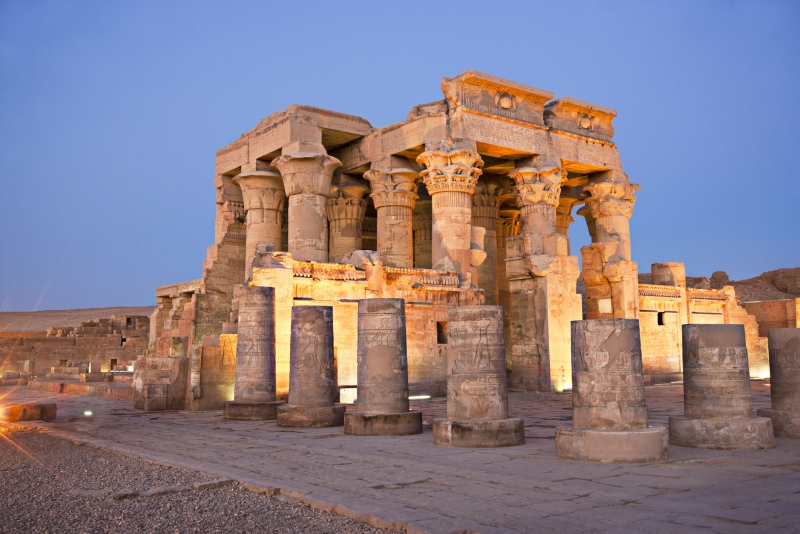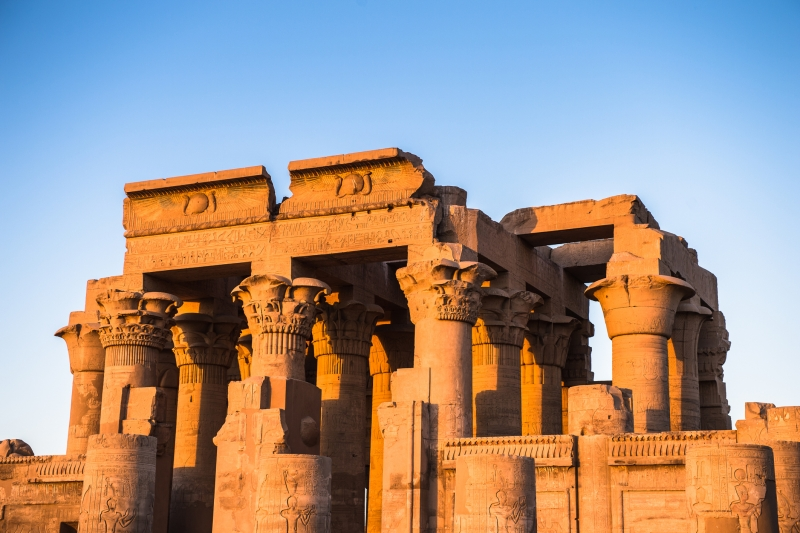Kom Ombo

Kom Ombo, once known as Nubt or the “City of Gold,” was a strategic settlement 50 km north of Aswan that controlled key Nile trade routes between Nubia and Egypt. Its crown jewel, the Temple of Kom Ombo, built in the 2nd century BC, became famous for its unique dedication to crocodile worship, with mummified crocodiles preserved nearby. Serving as a fortified garrison under the Ptolemies and Romans, Kom Ombo also holds historical significance for featuring what is believed to be the earliest depictions of surgical instruments, making it a rare blend of spirituality, military importance, and medical advancement.
Unveiling the Twin Temple Design
Kom Ombo is a unique Ptolemaic-era temple (180–47 BCE) later expanded by the Romans. It is the only ancient Egyptian temple built to honor two divine triads at once, making it an architectural rarity.
Why two temples in one structure?
Kom Ombo’s temple was uniquely designed to honor two rival deities—Sobek, the crocodile god, and Haroeris (Horus the Elder)—along with their divine triads. To avoid mythological conflict, the temple was built with dual sanctuaries and mirrored layouts, allowing separate priesthoods to perform rituals side by side. This innovative design created a rare space of religious harmony where differing beliefs coexisted within one sacred complex.
Architectural symmetry and symbolism
Kom Ombo’s temple is a masterpiece of bilateral symmetry, with mirrored entrances, courtyards, halls, and sanctuaries that reflect the balance between Sobek and Horus. This design symbolized the cosmic harmony of opposing forces in Egyptian belief. The main courtyard, featuring 16 painted columns and a central granite altar, showcases this perfect equilibrium, turning the temple into a physical expression of divine order.

The Gods of Kom Ombo
Kom Ombo’s temple uniquely honored two powerful deities in separate sanctuaries, reflecting the Egyptians’ sophisticated religious system. This dual dedication gave the site great spiritual significance, allowing two distinct traditions to coexist in harmony within one sacred complex.
Haroeris: The falcon-headed protector
Kom Ombo’s northern sanctuary was dedicated to Haroeris (Horus the Elder), the falcon-headed god symbolizing light, war, and divine authority. Unlike the child Horus, Haroeris represented a victorious, mature form of the deity, worshipped alongside his consort Tasenetnofret and their son Panebtawy. Known as the “Castle of the Falcon”, this sacred space was richly decorated with falcon imagery and inscriptions. His cult peaked in the 18th Dynasty, with priests honoring him as “father of the gods,” and temple reliefs famously show Haroeris granting Ptolemy VIII the sword of victory.
Sobek: The crocodile god of fertility
Kom Ombo’s southern sanctuary was devoted to Sobek, the crocodile god of fertility, creation, and Nile abundance. Despite associations with Seth, Sobek was deeply venerated as a protector and creator, believed to control water, floods, and agriculture. His triad included Hathor and Khonsu, and his temple, called the “House of the Crocodile,” was filled with crocodile imagery. Worship reflected both reverence and survival needs, as Nile crocodiles threatened daily life. Priests even kept live crocodiles, while many mummified crocodiles found nearby highlight his lasting cult significance.

Daily Life and Rituals in Ancient Kom Ombo
Sacred walls of Kom Ombo witnessed centuries of bustling activity where religious devotion intertwined with medical practice. Priests conducted elaborate ceremonies while healers administered to the afflicted, creating a unique sanctuary that served both spiritual and physical well-being.
Priests, offerings, and temple rituals
Two distinct priesthoods governed temple operations, each dedicated exclusively to their respective deity. These religious specialists orchestrated essential ceremonies three times daily, carefully presenting offerings to the divine statues within the twin sanctuaries. Temple calendars reflected precise astronomical observations, dividing each year into three distinct seasons that mirrored the Nile's natural rhythm: flooding (Akhet), growing (Peret), and harvest (Shemu).
Water level monitoring represented one of the priesthood's most critical responsibilities. A circular well known as a Nilometer provided essential data for calculating taxation and managing grain distribution. Sacred offerings encompassed food, drink, clothing, and fragrant ointments—each item considered vital sustenance for the divine spirits inhabiting the statues. These elaborate rituals extended far beyond symbolic gestures, forming the cornerstone of maintaining cosmic order (Ma'at) throughout the kingdom.
Medical instruments and healing practices
Archaeological evidence reveals Kom Ombo's remarkable function as an ancient medical center. Temple walls display intricate relief carvings depicting sophisticated surgical instruments, including scalpels, curettes, forceps, specula, scissors, and medicine bottles. These extraordinary artistic records, enhanced by images of goddesses seated on birthing chairs, demonstrate that Egyptian medical knowledge arguably surpassed all contemporary civilizations.
Pilgrims traveled great distances seeking divine healing within these sacred chambers. Priestly physicians combined spiritual intervention with practical treatments, utilizing honey for its remarkable anti-bacterial qualities. Ancient medical texts indicate that onion juice served as an effective remedy for various eye ailments. Designated healing chambers functioned as sophisticated medical facilities throughout the complex, where therapeutic rituals unfolded under Haroeris's protective guidance—the deity sometimes revered as the "head of physicians".

Customize Your Dream Vacation!
Get in touch with our local experts for an unforgettable journey.
Plan Your Trip
Legacy and Preservation Today
Centuries of abandonment gave way to an extraordinary archaeological awakening when French explorer Jacques de Morgan initiated the temple's restoration in 1893, focusing his efforts on clearing Sobek's sacred domain. This marked the beginning of Kom Ombo's modern rediscovery, setting the stage for decades of fascinating revelations.
Tourism and archaeological importance
Archaeological teams continue to unearth treasures that reshape our understanding of this ancient site. The year 2018 proved particularly rewarding when excavators revealed a collection of remarkable artifacts: a sandstone sphinx bearing Ptolemaic characteristics, a dignified bust of Roman Emperor Marcus Aurelius, and two exceptionally preserved ancient paintings. These discoveries paint a vivid picture of Kom Ombo's multicultural heritage, where Egyptian, Greek, and Roman influences converged.
The Crocodile Museum now houses nearly three hundred mummified crocodiles recovered from the surrounding area, offering visitors a direct connection to the ancient worship practices that once defined this sacred space. Each mummy tells a story of devotion to Sobek, the fearsome yet revered crocodile deity.
Modern preservation science has stepped forward to protect these irreplaceable treasures. The United States Agency for International Development undertook an ambitious $9 million groundwater management project, completed in 2019, specifically designed to halt the rising water levels that threatened the temple's foundation. This intervention forms part of USAID's remarkable quarter-century commitment—a $100 million investment dedicated to safeguarding Egypt's cultural monuments. For travelers joining Egypt tours, these preservation efforts ensure that Kom Ombo Temple and other ancient landmarks remain accessible and awe-inspiring for generations to come. The urgency of such efforts becomes clear when considering how groundwater, salt, and heat combined to slowly erode the ancient hieroglyphs carved into the temple's sandstone walls.
Modern Kom Ombo and its evolving identity
Archaeological evidence reveals an extraordinary timeline of human habitation stretching from the Early Dynastic Period (3000-2686 BC) through the early Islamic conquest (639-646 AD). Recent investigations by the Austrian Archaeological Institute, launched in 2017, have uncovered evidence of a substantial settlement covering at least three hectares during the third millennium BC. These findings suggest Kom Ombo held administrative importance far beyond its religious significance.
Contemporary Kom Ombo presents a fascinating blend of ancient heritage and modern agricultural productivity. The town's 60,000 residents cultivate vast expanses of sugarcane and cereal crops, maintaining the fertile traditions that first drew settlers to these Nile banks. The population represents a rich cultural tapestry, including native Egyptians and Nubian communities, particularly the Magyarabs who relocated here following the creation of Lake Nasser.
Future developments promise to honor this legacy while embracing modern possibilities. Plans announced in 2010 envision a $700 million solar power facility generating 100 MW of clean energy, demonstrating how Kom Ombo continues to serve Egypt's evolving needs. This ambitious project symbolizes the town's enduring significance—from ancient gold trade center to modern renewable energy hub, always adapting while preserving its essential character.
When you visit Kom Ombo Temple in Upper Egypt near Aswan, you’ll immediately notice its unusual design. Unlike other temples along the Nile, Kom Ombo is perfectly symmetrical, with two identical halves dedicated to two different gods—Sobek, the crocodile god, and Haroeris (Horus the Elder). This dual layout represents the ancient Egyptian belief in balance and harmony between opposing forces. Exploring the temple during a Nile cruise tour gives you a firsthand look at how architecture reflected spiritual philosophy in ancient Egypt.
The name has both Arabic and ancient Egyptian roots. “Kom” means “small hill” in Arabic, while “Ombo” in ancient Egyptian refers to “gold.” Together, Kom Ombo means “hill of gold.” This name reflects the region’s historical role as a center of gold trade in Upper Egypt. When you stop here on an Aswan tour or Nile cruise, you’ll understand why this site was considered so valuable throughout history.
Kom Ombo Temple is dedicated to two powerful deities. On one side, worshipers honored Sobek, the crocodile god linked to fertility and protection. On the other, they revered Haroeris (Horus the Elder), the falcon-headed god of strength and healing. Each god has its own sanctuary within the temple, and you can explore both sections when you visit. Nearby, you can also see the Crocodile Museum, where mummified crocodiles found at Kom Ombo are on display—something you won’t find anywhere else in Egypt.
One of the most fascinating things you’ll see at Kom Ombo Temple are the reliefs carved into its walls. These carvings depict surgical instruments, including scalpels, forceps, and medicine bottles. This shows that the temple wasn’t just a religious site but also a place of healing, functioning almost like an early hospital. When you tour the site, it feels like stepping back into an ancient medical center where religion and medicine were closely linked.
Preserving Kom Ombo is a major priority for Egypt. In recent years, a $9 million groundwater-lowering system funded by USAID was installed to protect the temple from water damage caused by the Nile. Archaeologists continue to excavate new artifacts, adding to what we know about the site’s history. When you include Kom Ombo in your Egypt tours, you’re not only visiting a stunning temple—you’re supporting efforts to keep this treasure safe for future generations.








